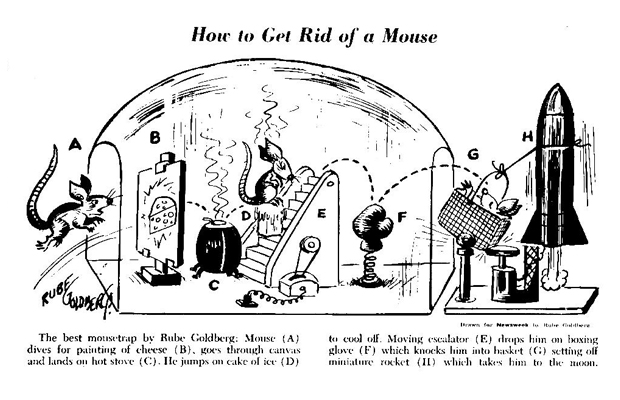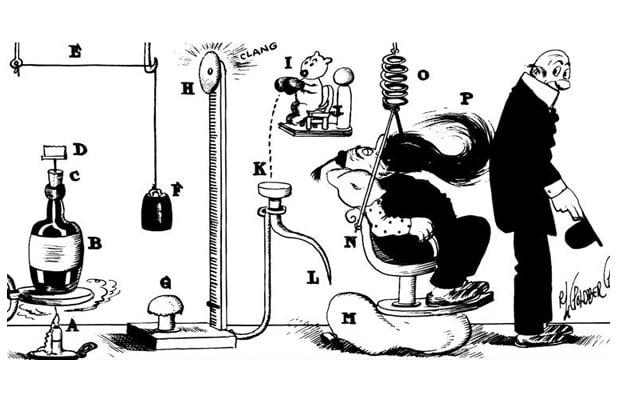Origin Stories: A History Of Rube Goldberg Machines, And A List Of The Best
On the endless popularity of completely ludicrous machinery.


For more original people, places and ideas head to
Everything has its beginning; an inception point, or nucleus. We’ve teamed up with ORGNL.TV, a new editorial channel by Stolichnaya Premium Vodka to bring you a fortnightly series in which we peel back the curtain and pinpoint the moment of origin of something happening now.
–
If you all forgot to mark your calendars, November was International Month of Everyone on the Internet Celebrating This Toy Ad For a While.
Here it is again, just in case you missed it.
The ad for GoldiBlox, featuring a trio of female tikes fed up with the doll-and-makeup malarkey being forced on them, was the absolute best thing to happen in the women’s empowerment movement since suffrage. Or it was just another example of princess peddling, where one of the few engineering feats the young women who played with these toys could achieve was the building a Little Miss Parade Float. Or it was a blatant infringement of copyright that caused the Beastie Boys to threaten legal action, which caused the toy brand to replace their parody with a new soundtrack. (Or, of course, it wasn’t copyright infringement at all.)
Either way, it is undeniably very fun to watch a tennis ball tip over a golf club, which in turn hits loose a see-saw that operates boot on a lever that starts a whirligig spinning so that a domino effect comes into play. There will be time enough to dissect the gender politics behind pink and purple building blocks (and the implication for Australia’s own copyright law debate), but there is fortunately one thing that we can all agree on: that Rube Goldberg machines are rad.
–
What Even Is A Rube Goldberg?
Reuben Garrett Lucius Goldberg was born on July 4 in 1883 and, after a brief dalliance in the exciting world of sewage engineering, settled into his career as a cartoonist. Goldberg was the writer and artist behind comic strips featuring excellently named characters such as Boob McNutt, Lala Palooza and Professor Lucifer Gorgonzola Butts — and it was in Butts that Goldberg found his true calling.
Professor Butts was the creator of incredible inventions, including the Self-Operating Napkin and the Simple Machine for Getting Rid of Mice, all of which took the easiest of everyday operations and turned them into the most ludicrous contraptions. Relying on pulleys, wheels, springs, gravity, flame and wind, Rube Goldberg’s ridiculously contrived cartoons were such a hit that in 1931, Miriam Webster dictionaries entered his name into their records to describe just such devices.
The trick to a Rube Goldberg is to make the simple complex — but it can’t all just be clockwork precision. The joy in his blueprints comes from the inclusion of the every day; not just in the jerry-rigged fry pans, fireworks and fishbowls, but in using the emotional outbursts of birds, animals and people. Goldberg’s machines often rely on hungry squirrels, excited penguins and startled chickens to keep procedures moving along. His simple way to brush dandruff from one’s coat incorporates some sort of boxing gloved marmot leaping from his stool and ready for a fight…
Goldberg’s cartoons became popular in the same era that machinery entered the everyday lives of many average people. The car and television were becoming affordable for the middle classes, and suddenly families were in possession of household items that operated at levels far beyond their understanding. I still mentally refer to that scene in Willy Wonka when I think about how the moving pictures travel from the studio and into my magic speaking box. Having step-by-step diagrams explaining the ludicrous gadgets of tomorrow must have been as reassuring as they were humorous for the audiences that lapped them up. Being that I don’t have Gene Wilder to explain to me any of the things my phone can now do, I feel similarly lost when it comes to technology.
The early days of Hollywood comedy capitalised on the popularity of Rube Goldberg-styled devices, with the Three Stooges and Looney Tunes cartoons incorporating real-time comedic timing as a compliment to the already outlandish orchestration implied by the drawings. Moviemakers, especially auteurs of whimsy like Spielberg, Burton, Gilliam and Jean-Pierre Jeunet, still thrill to the possibilities of just how you can get a bowling ball to turn on a light switch in 435 very complicated steps.
It’s no wonder that we’re still delighted by Rube Goldberg-styled devices – I can’t wrap my head around The Cloud, but popping a balloon to startle a hamster to turn a wheel to strike a match to boil a kettle to turn a fan to pull a string to water a pot plant? That’s simple. Here’s some of our favourite Rube Goldberg devices in pop culture.
–
The Roadrunner Show (1957)
Just one of many instances when Wile E. Coyote took the scenic route in his machinations to dispose of the Roadrunner. Had Acme Novelties been a real life company, I suspect Rube Goldberg could have gained easy employment, upselling a bowling bowl with every purchase as a necessary facet of the simplest of household procedures.
Rube Rating: Seven springs and a bowling ball.
–
Chitty Chitty Bang Bang (1968)
Depending on your tolerance for Dick Van Dyke schmaltz, this clip might be a tough watch, but it’s worth it to see another example of an incredible Goldberg breakfast machine.
This one loses points for insinuating that you can cook an egg and sausage on the same china plate you intend to serve them on. One step too ridiculous, you guys.
Rube Rating: Two balloons and a pinwheel.
–
The Goonies (1985)
While we’re all fans of the Truffle Shuffle, it’s Data’s gadgets in this film that really captured my imagination as a youth. Nothing screams “kid’s club” like doing something simple in a very complicated manner (see: secret handshakes, pulley systems, and walkie-talkies when you’re in the same room) — so it’s no wonder that Chunk has to wait for a chicken to feel like laying an egg just so the gate latch can be flipped and he can enter the front yard.
Rube Rating: Six marbles and two mousetraps.
–
Pee-Wee’s Big Adventure (1985)
Pee-Wee Herman’s whole life appears to be controlled by the bizarre rules of suspended childhood, and his breakfast is too. This is a Goldberg machine supreme – comprising candles, toys, dinosaurs, Lincoln and more, with an estimated set up of time of hours the evening before.
The fact that Peewee then pours cereal by hand on top of the end result, and even then only eats three or four flakes, is the icing on top. It’s all so necessary in its unnecessariness.
Rube Rating: One very small rocketship out of three.
–
The Great Mouse Detective (1986)
This lesser known Disney film from the ’80s is a rodent reimagining of Holmes and Watson, as they go head to head against the evil Rattigan. This clip features them trapped in a Goldberg-esque device of death, that comes complete with an olde-timey camera set up to capture the gory end of the film’s heroes.
Basil, the titular detective, calculates a malfunction that must have seemed inconceivable when his enemy decided the best way to be rid of the mouse was to build a bizarre and unwieldy contraption.
Rube Rating: Two feather dusters under a mustachioed man.
–
Back to the Future III (1990)
One more breakfast machine. This one relies a little too heavily on clockwork for us – where are the bursting balloons and excitable animals? We never thought we’d call Doc Brown too serious, but he seems to have missed an opportunity or two here for some levity. If you’re trapped in the Wild West, Doc, why not have a feather duster making a horse sneeze play a role in your morning routine? Rube would’ve done it.
Rube Rating: One sinking toy sailboat.
–
Flight of the Conchords (2008)
This one is a cheat, as the step-by-step occurrences that cause the mug to break are accidental, and not formulated as a time- or labour-saving device. But the whole episode is in the spirit of Goldberg, as Brett’s purchase of a cheap cup sets off one financial misadventure after another, culminating in the rather cute elimination of the item that begun it all.
Rube Rating: A baseball glove full of pudding.
–
Elementary (2012)
Elementary is just one of television’s current modern day retellings of Sherlock Holmes, and its opening credits display a step-by-step cause and effect of the trapping of a man: a perfect representation of how Holmes’ mind links clue to clue in the solving of a case.
I don’t believe this machine actually appears in the show outside of its metaphorical existence in the credits, which is a shame. It seems like the version of Mousetrap you purchase on the day you become an insane millionaire.
Rube Rating: A cat that is about to be shown a mirror.
–
BONUS CLIPS!
These two videos contain fantastic devices in the spirit of Goldberg, and yet the final effect of them, to splatter paint and shoot an arrow, miss the end goal. It’s one thing to create a mutli-step, burdensome, unreliable invention for the purpose of doing something important, like operating a napkin or turning off the TV; making one just for the sake of fun is kind of a waste of time.
–
The Bravery: ‘An Honest Mistake’ (2004)
–
OK GO: ‘This Too Shall Pass’ (2010)
–
Matt Roden helps kids tell stories by day at the Sydney Story Factory, and by night helps adults admit to stupidity by co-running Confession Booth and TOD Talks. He is 2SER’s resident TV critic — each Tuesday morning at 8.20am — and his illustration and design work can be seen here.

